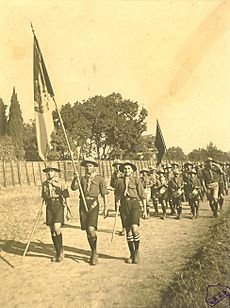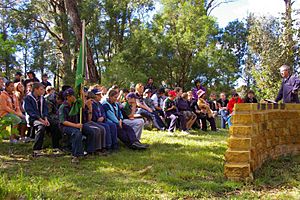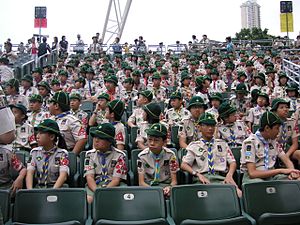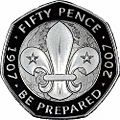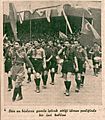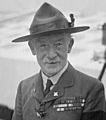Scouting facts for kids
Quick facts for kids Scouting |
|||
|---|---|---|---|
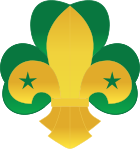 |
|||
| Country | Worldwide United Kingdom (origin) |
||
| Founded | 1907, Brownsea Island | ||
| Founder | Robert Baden-Powell, 1st Baron Baden-Powell | ||
|
|
|||
Scouting, also known as the Scout Movement, is a worldwide youth movement. It was started in 1907 by Robert Baden-Powell as a movement for boys.
Baden-Powell took many ideas from the experiences he made with the Mafeking Cadet Corps. This corps was a paramilitary group made of boys. It was formed during a siege in the Second Boer War. The boys mainly carried messages. This was so the soldiers could focus on defending the city.
Originally, the Scout movement was for boys only. A similar movement for girls, called "Girl Guides" was started in 1910. In most countries there are associations for Scouts and for Girl Guides. Today the Scouts often accept girls, too.
In the Scout movement, people learn to work together to achieve a goal. They also train their character to become better adults. Usually Scouts give a promise to live by certain rules, and to help others when they can.
Scouts spend their time outdoors, whenever possible. Their outdoor activities include camping, woodcraft, aquatics, hiking, backpacking, and sports.
Another widely recognized movement characteristic is the Scout uniform, with neckerchief and campaign hat or comparable headwear. Distinctive uniform insignia include the fleur-de-lis and the trefoil, as well as merit badges and other patches.
Contents
How many Scouts there are
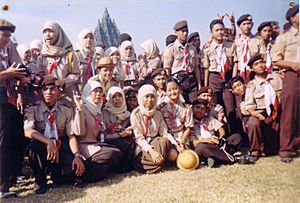
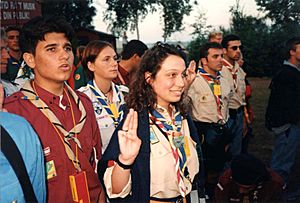
In 2007, Scouting and Guiding together had over 38 million members in 216 countries. International umbrella organizations include:
- World Organization of the Scout Movement (WOSM), for boys-only and co-educational organizations
- World Association of Girl Guides and Girl Scouts (WAGGGS), primarily for girls-only organizations but also accepting co-educational organizations
- World Federation of Independent Scouts
- World Organization of Independent Scouts
- Order of World Scouts
- International Union of Guides and Scouts of Europe
- Confederation of European Scouts
How it started

Baden-Powell was a military officer. He was stationed in India and Africa in the 1880s and 1890s. Since his youth, he was fond of woodcraft and military scouting. He therefore showed his men how to survive in the wilderness. He noticed that if he taught the soldiers to develop independence, they would no longer follow the orders given by their officers blindly.
In 1896, during the Second Matabele War, Baden-Powell first met and became friends with the American-born British Army Chief of Scouts Frederick Russell Burnham. From Burnham he learned the ways of cowboy and Indian scouts of the Western United States, he started to wear a scout hat like the one worn by Burnham, and he discussed with Burnham a scout training program for boys. Three years later during the Second Boer War, Baden-Powell was besieged in the small town of Mafeking by a much larger Boer army (the Siege of Mafeking). The Mafeking Cadet Corps was a group of youths that supported the troops. The cadets carried messages. This freed the men for military duties. It also kept the boys occupied during the long siege. The Cadet Corps performed well, helping in the defence of the town (1899–1900). This experience was one of the many factors that inspired Baden-Powell to form the Scouting movement. Each member received a badge that showed a combined compass point and spearhead. The badge's logo was similar to the fleur-de-lis that Scouting later adopted as its international symbol.
In the United Kingdom the public followed his struggle to hold Mafeking through newspapers. After the siege, Baden-Powell had become a national hero. This pushed the sales of a small instruction book he had written about military scouting, Aids to Scouting.
On his return to England he noticed the large interest of boys in this book, which was also used by teachers and youth organizations. Several people suggested to him to rewrite this book for boys, especially during an inspection of the Boys' Brigade. This brigade was a large youth movement, drilled with military precision. Baden-Powell thought this would not be attractive and suggested that it could grow much larger when scouting would be used. He studied other schemes, parts of which he used for Scouting.
The original Scout law
- A Scout's honour is to be trusted - This means the scout will try as best as he can to do what he promised, or what is asked of him
- A Scout is loyal - to his king or queen, his leaders and his country.
- A Scout's duty is to be useful, and to help others
- A Scout is a friend to all, and a brother to every other Scout - Scouts help each other, regardless of the differences in status or social class.
- A Scout is courteous - He is polite and helpful to all, especially women, children, and the elderly. He does not take anything for being helpful.
- A Scout is a friend to animals - He does not make them suffer, or kill them without need to do so.
- A Scout obeys orders - Even the ones he does not like.
- A Scout smiles and whistles
- A Scout is thrifty - he avoids unnecessary spending of money.
- A Scout is clean in thought, word and deed (added later)
(When these laws were made in 1907, there were no Girl Scouts; of course the laws apply to Girl Scouts all the same)
The promise of 1907
In his original book on boy scouting, General Baden-Powell introduced the Scout promise, as follows:
Before he becomes a scout, a boy must take the scout's oath, thus:
On my honour I promise that---
- I will do my duty to God and the Queen.
- I will do my best to help others, whatever it costs me.
- I know the scout law, and will obey it.
While taking this oath the scout will stand, holding his right hand raised level with his shoulder, palm to the front, thumb resting on the nail of the little finger and the other three fingers upright, pointing upwards:--- This is the scout's salute and secret sign.
(This was later adapted to different countries, and organisations)
Age groups and sections
Scouting and Guiding movements are generally divided into sections by age or school grade, allowing activities to be tailored to the maturity of the group's members. These age divisions have varied over time as they adapt to the local culture and environment.
Scouting was originally developed for adolescents—youths between the ages of 11 and 17. In most member organizations, this age group composes the Scout or Guide section. Programs were developed to meet the needs of young children (generally ages 6 to 10) and young adults (originally 18 and older, and later up to 25). Scouts and Guides were later split into "junior" and "senior" sections in many member organizations, and some organizations dropped the young adults' section. The exact age ranges for programs vary by country and association.
| Age range | Boys section | Girls section |
|---|---|---|
| 8 to 10 | Wolf Cubs | Brownie Guide |
| 11 to 17 | Boy Scout | Girl Guide or Girl Scout |
| 18 and up | Rover Scout | Ranger Guide |
The national programs for younger children include Tiger Cubs, Cub Scouts, Brownies, Daisies, Rainbow Guides, Beaver Scouts, Joey Scouts, Keas, and Teddies. Programs for post-adolescents and young adults include the Senior Section, Rover Scouts, Senior Scouts, Venture Scouts, Explorer Scouts, and the Scout Network. Many organizations also have a program for members with special needs. This is usually known as Extension Scouting, but sometimes has other names, such as Scoutlink. The Scout Method has been adapted to specific programs such as Air Scouts, Sea Scouts, Rider Guides and Scoutingbands.
In many countries, Scouting is organized into neighborhood Scout Groups, or Districts, which contain one or more sections. Under the umbrella of the Scout Group, sections are divided according to age, each having their own terminology and leadership structure.
Other Scout-like organisations

Since the Scouts were formed, other people have tried to form scout-like movements. These movements are a bit like the Scouts, but they put more weight on different things. There are for example Scout-like movements that focus more on the fact that the young people should get a good education in religious matters. The movements that have been formed in countries such as Cuba or China are much like Scouts; they leave out some elements though, that the national governments thought would harm the country.
Related pages
Images for kids
-
A 2007 British fifty pence coin commemorating the 100th anniversary of the founding of the Scout Movement
-
U.S. President Calvin Coolidge greeting 1500 Boy Scouts making an annual trip to the Capitol, 1927
-
Girl Guides in front of a Catholic church in Poland
-
Sculpture erected in 1982 to commemorate the 1979 Jamboree at Perry Lakes Western Australia and 75 years of Scouting
-
Robert Baden-Powell, founder of the Scouting movement
-
A parade of Finnish scouts in front of the Turku Cathedral on May 6, 2012
See also
 In Spanish: Escultismo para niños
In Spanish: Escultismo para niños


